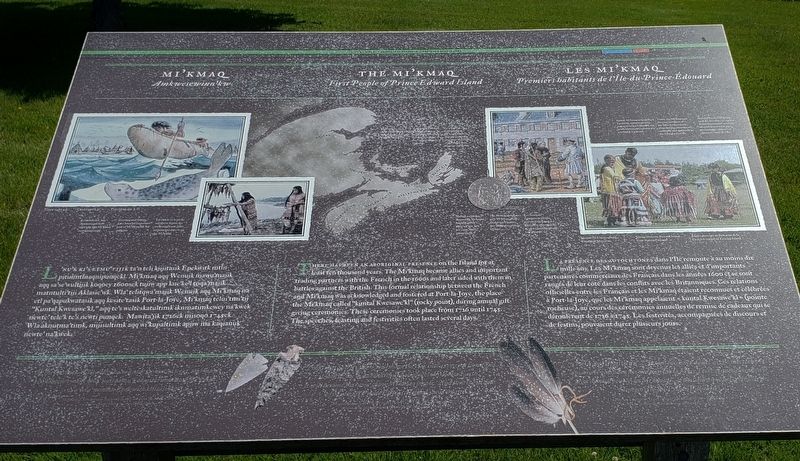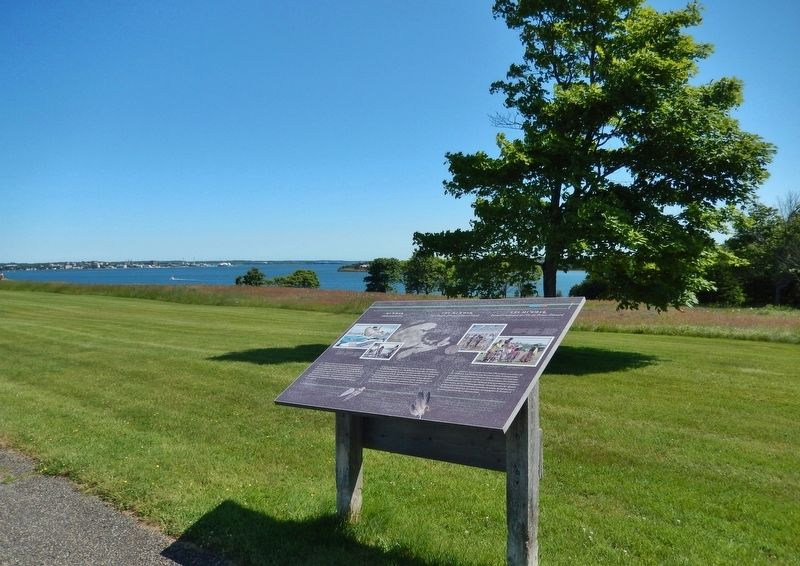Rocky Point in Queens County, Prince Edward Island — The Atlantic Provinces (North America)
The Mi'kmaq / Les Mi'kmaq
First People of Prince Edward Island / Premiers habitants de l'Île-du-Prince-Édouard
There has been an aboriginal presence on the Island for at least ten thousand years. The Mi’kmaq became allies and important trading partners with the French in the 1600s and later sided with them in battles against the British. This formal relationship between the French and Mi’kmaq was acknowledged and fostered at Port-la-Joye, the place the Mi’kmaq called “kuntal Kwesawe’kl” (rocky point), during annual gift-giving ceremonies. These ceremonies took place from 1726 until 1745. The speeches, feasting and festivities often lasted several days.
Traditional Mi’kmaq territory includes most of the Maritime Provinces and part of the Gaspé peninsula of Québec.
”The Great Spirit said, ‘I will shape the clay into a crescent form and it will be the most beautiful of all places on Mother Earth. It will become the home of my Mi’kmaq people.’ And thus the island of Minegoo [Prince Edward Island] was created.”
—Micmac Legends of Prince Edward Island (1988), Dr. John Joe Sark LLD (Hon.), Keptin of the Mi’kmaq Grand Council for the District of Epekwitk (PEI)
La présence des autochtones dans l’Île remonte à au moins dix mille ans. Les Mi’kmaq sont devenus les alliés et d’importants partenaires commerciaux des Français dans les années 1600 et se sont rangés de leur côté dans les conflits avec les Britanniques. Ces relations officielles entre les Français et les Mi’kmaq a étaient reconnues et célébrées à Port-la-Joye, que les Mi’kmaq appelaient « kuntal Kwesawe’kl » (point rocheuse), a cours des cérémonies annuelles de remise de cadeaux qui se déroulèrent de 1726 à 1745. Les festivités, accompagnées de discours et de festins, pouvaient durer plusieurs jours.
Le territoire traditionnel des Mi’kmaq couvre la majeure parte des provinces maritimes et une partie de la Gaspésie au Québec.
« Le Grand Esprit a dit: "Je vais façonner dans l’argile un croissant que sera le plus beau des endroits sur la Mère Terre et qui deviendra le foyer de mon peuple, les Mi’kmaq," et c’est ainsi que fut créée l’Île de Minegoo [Île-du-Prince-Édouard]. »
—Micmac Legends of Prince Edward Island (1988), John Joe Sark (F.S.D.), Keptin du Mi’kmaq Grand conseil des Mi’kmaq, district d’Epekwitk (Î.-P.-É.)
Topics. This historical marker is listed in these topic lists: Colonial Era • Industry & Commerce • Native Americans • Settlements & Settlers.
Location.
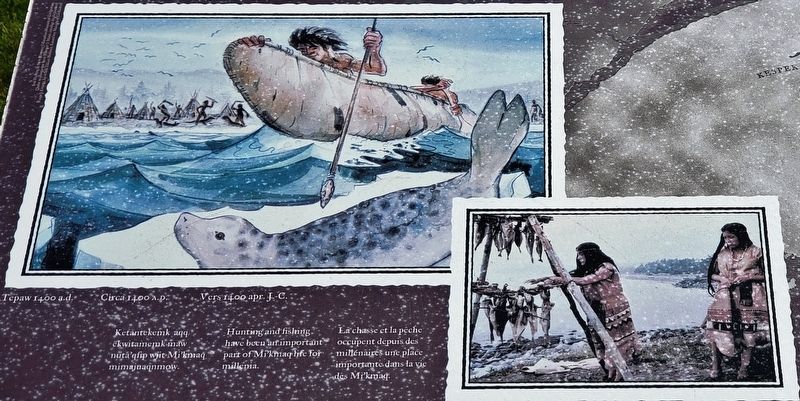
Photographed By Steve Bloomer, Canadian Museum of Civilization
2. Marker detail: Seal Hunting, circa 1400 A.D. /
Chasse au phoque, Vers 1400 apr. J.C.
Chasse au phoque, Vers 1400 apr. J.C.
• • •
La chasse et la pêche occupent depuis des millénaires une place importante dans la vie des Mi’kmaq.
Other nearby markers. At least 8 other markers are within walking distance of this marker. Place Yourself in History / Situez-vous dans l’histoire (within shouting distance of this marker); Michel Haché-Gallant et Anne Cormier (within shouting distance of this marker); Port of Entry / Port d’entrée (within shouting distance of this marker); The Deportation of the Inhabitants of Île Saint-Jean (within shouting distance of this marker); Port-la-Joye – Fort Amherst (within shouting distance of this marker); The British Period / La période britannique (about 120 meters away, measured in a direct line); A Great Survey / Un Arpentage de Taille (about 120 meters away); The Grand Dérangement (about 150 meters away). Touch for a list and map of all markers in Rocky Point.
Related markers. Click here for a list of markers that are related to this marker. Skmaqn–Port-la-Joye–Fort Amherst National Historic Site
Also see . . .
1. Mi'kmaq.
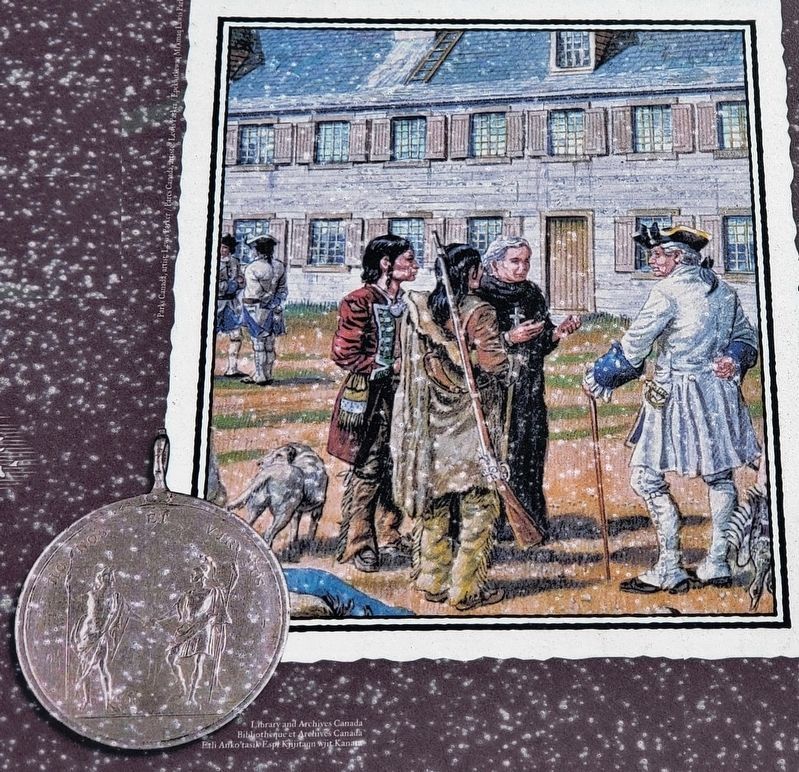
Courtesy Parks Canada, artist: Lewis Parker
3. Marker detail: Exchanging gifts / échange de cadeaux
• • •
Les Français remettaient parfois aux chefs Mi’kmaq des médailles, comme celle-ci en l’honneur de leur alliance.
2. John Joe Sark. John Joe Sark’s role as a spiritual leader for the Mi’Kmaq people has built a lasting bridge of understanding between cultures. As a representative of the Mi’Kmaq Council, Mr. Sark has lobbied internationally for rights and recognition. He has had audiences with the Pope on the subject of residential schools. He was involved in drafting the United Nations’ Declaration of Indigenous Peoples of the World, and was co-producer, executive director and artistic director of the film “Spirit World – The Story of the Mi’Kmaqs”. (Submitted on June 27, 2020, by Cosmos Mariner of Cape Canaveral, Florida.)
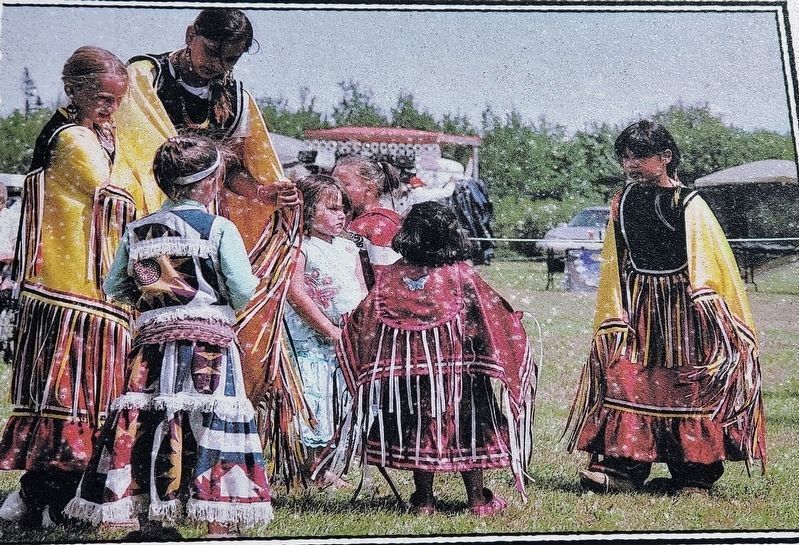
Courtesy Mi’kmaq Confederacy P.E.I.
4. Marker detail: Young Mi’kmaq Dancers /
Jeunes danseurs Mi’kmaq
Jeunes danseurs Mi’kmaq
• • •
Jeunes danseurs au Pow-wow de la Première nation de Lennox Island. Aujourd’hui, les Mi’kmaq sont des membres prospères de la communauté insulaire et contribuant sur le plan économique, culturel et spirituel à la vie de l’Île.
Credits. This page was last revised on June 27, 2020. It was originally submitted on June 23, 2020, by Cosmos Mariner of Cape Canaveral, Florida. This page has been viewed 272 times since then and 39 times this year. Photos: 1, 2. submitted on June 26, 2020, by Cosmos Mariner of Cape Canaveral, Florida. 3, 4. submitted on June 27, 2020, by Cosmos Mariner of Cape Canaveral, Florida. 5. submitted on June 26, 2020, by Cosmos Mariner of Cape Canaveral, Florida.
